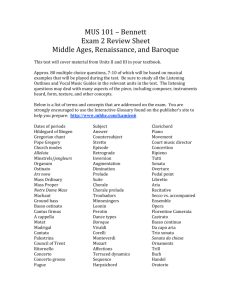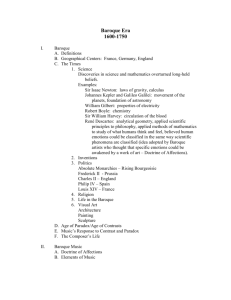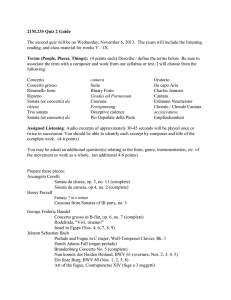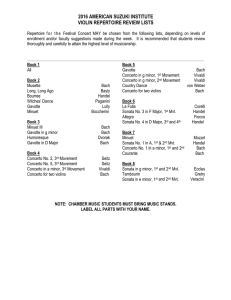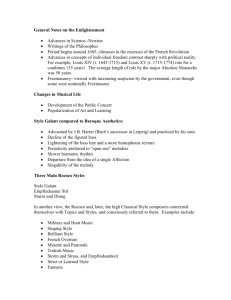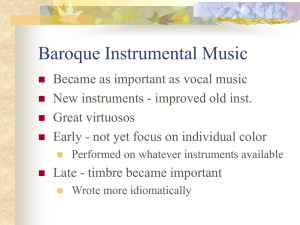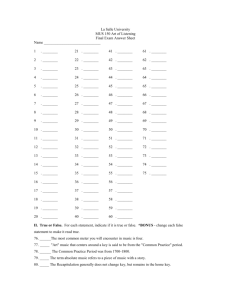Use the following answers for questions 1-3. Harpsichord Clavichord
advertisement
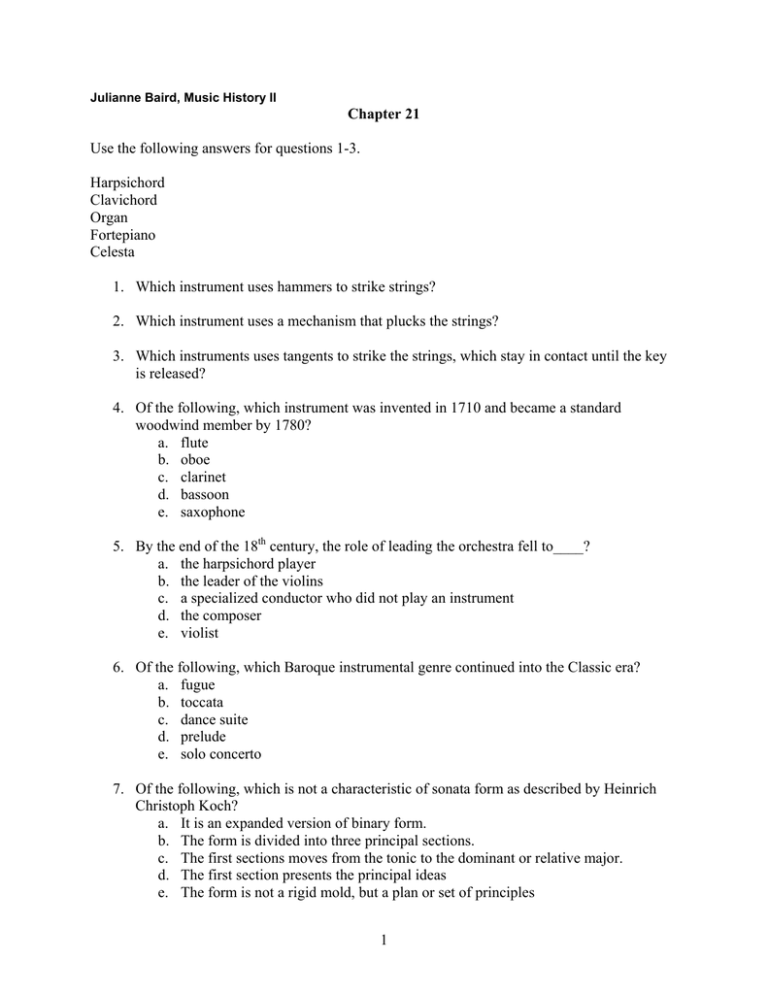
Julianne Baird, Music History II Chapter 21 Use the following answers for questions 1-3. Harpsichord Clavichord Organ Fortepiano Celesta 1. Which instrument uses hammers to strike strings? 2. Which instrument uses a mechanism that plucks the strings? 3. Which instruments uses tangents to strike the strings, which stay in contact until the key is released? 4. Of the following, which instrument was invented in 1710 and became a standard woodwind member by 1780? a. flute b. oboe c. clarinet d. bassoon e. saxophone 5. By the end of the 18th century, the role of leading the orchestra fell to____? a. the harpsichord player b. the leader of the violins c. a specialized conductor who did not play an instrument d. the composer e. violist 6. Of the following, which Baroque instrumental genre continued into the Classic era? a. fugue b. toccata c. dance suite d. prelude e. solo concerto 7. Of the following, which is not a characteristic of sonata form as described by Heinrich Christoph Koch? a. It is an expanded version of binary form. b. The form is divided into three principal sections. c. The first sections moves from the tonic to the dominant or relative major. d. The first section presents the principal ideas e. The form is not a rigid mold, but a plan or set of principles 1 8. Which of the following would be considered a rondo form? a. ABACADA b. ABA c. Rounded binary d. A repeated with variations e. ABAB 9. The composer who published some of his keyboard sonatas with the title Essercizi was _______. a. J.C. Bach b. Domenico Alberti c. Domenenico Scarlatti d. C.P. E. Bach e. J.S. Bach 10. Of the following, which does not describe the sonatas of C.P.E. Bach? a. They helped to establish the three movement structure b. They sustain the Baroque style well into the Classic era. c. They often contain expressive melodies with short phrases d. In them, Bach introduced sections of dialogue and recitative e. They exemplify the empfindsam style 11. In which region did the symphony originate? a. Italy b. France c. Austria d. England e. Germany USE THE FOLLOWING ANSWERS FOR QUESTIONS 12-16 a. Stamitz b. Gossec c. Wagenseil d. Sammartini e. J.C Bach 12. This Italian was the first important composer of symphonies 13. Writing in Vienna, his symphonies featured contrasting themes. 14. Active in London, he was an important influence on the young Mozart. 15. He is considered to be one of the leading composers of symphonies in France. 2 16. He was the founder of the symphony school in Mannheim. 17. Which center developed an orchestra, referred to as “an army of generals,” that was renowned throughout Europe for its precision and technique? a. Milan b. Stuttgart c. Vienna d. Mannheim e. Paris 18. The Classic-era genre that combines characteristics of the symphony and the concerto is called the_____? a. divertimento b. symphonie concertante c. sinfonia d. concerto grosso e. cassation 19. Of the following, what characterizes the concerto form of J.C. Bach? a. The opening ritornello modulates to the dominant b. There are five principal solo sections c. The first solo section contains no thematic material. d. The ritornellos serve as a frame for a sonata form structure e. There are typically four movements 20. Of the following, what does not characterize a concerto cadenza in the Classic era? a. It was usually improvised b. A heavy orchestral 6/4 chord introduced the cadenza c. The soloist signaled the end of a cadenza with a trill d. The cadenza was placed at the end of the second solo section e. The cadenza developed from the vocal arias. SHORT ESSAY 1. Compare the descriptions of sonata form by Koch and by theorists of the early 19th century. How does sonata form differ from instrumental forms of the Baroque? 2. Using the model of a sonata form by Koch, analyze the movement in your anthology by Sammartini NAWM 100 p. 68 3. Describe how elements of Empfindsam style are reflected in the sonata movement of C.P.E. Bach NAWM 99 p. 64. Compare these to the characteristics of the galant style found in the concerto movement of J.C. Bach NAWM 102 p. 84. 4. Describe how the first movement of the late-eighteenth-century concerto combines the formal traditions of the Baroque concerto with sonata form. 3 TERMS FOR IDENTIFICATION: Clavichord Fortepiano String quartet Sonata Exposition Development Recapitulation Coda Slow-movement sonata form Variations form Minuet and trio form Rondo form Essercizi Frederick the Great Sinfonia Mannheim Symphonie concertante Concerto first-movement Cadenza Divertimento 4
